NCERT Solutions Class 10 Science Chapter 7 Control and Coordination have been provided below and is also available in Pdf for free download. The NCERT solutions for Class 10 Science have been prepared as per the latest syllabus, NCERT books and examination pattern suggested in Class 10 by CBSE, NCERT and KVS. Questions given in NCERT book for Class 10 Science are an important part of exams for Class 10 Science and if answered properly can help you to get higher marks. Refer to more Chapter-wise answers for NCERT Class 10 Science and also download more latest study material for all subjects. Chapter 7 Control and Coordination is an important topic in Class 10, please refer to answers provided below to help you score better in exams
Chapter 7 Control and Coordination Class 10 Science NCERT Solutions
Class 10 Science students should refer to the following NCERT questions with answers for Chapter 7 Control and Coordination in Class 10. These NCERT Solutions with answers for Class 10 Science will come in exams and help you to score good marks
Chapter 7 Control and Coordination NCERT Solutions Class 10 Science
Question : What is the difference between a reflex action and walking?
Answer: A reflex action is a rapid, automatic response to a stimulus. It does not involve any thinking. For example, we close our eyes immediately when the bright light is focused. Walking, on the other hand, is a voluntary action. It is under our conscious control.
Question : What happens at the synapse between two neurons?
Answer: A very small gap that occurs between the last portion of axon of one neuron and the dendron of the other neuron is known as a synapse. It acts as a one way valve to transmit impulses in one direction only. This uni-direction transfer of impulses occurs as the chemicals are produced in only one side of the neuron i.e., the axon’s side. From axon, the impulses travel across the synapse to the dendron of the other neuron. A synapse or neuromuscular junction
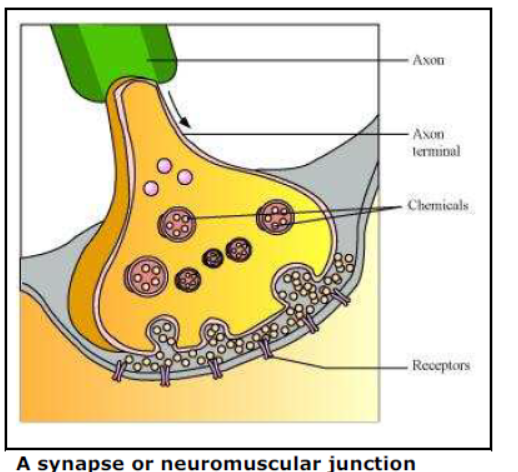
Question : Which part of the brain maintains posture and equilibrium of the body?
Answer: Cerebellum, a part of hindbrain is responsible for maintaining posture and equilibrium of the body.
Question : How do we detect the smell of an agarbatti (incense stick)?
Answer: The thinking part of our brain is the forebrain. It has separate areas that are specialized for hearing, smelling, sight, taste, touch, etc. The forebrain also has regions that collect information or impulses from the various receptors. When the smell of an incense stick reaches us, our forebrain detects it. Then, the forebrain interprets it by putting it together with the information received from other receptors and also with the information already stored in the brain.
Question : What is the role of the brain in reflex action?
Answer: Reflex actions are sudden responses, which do not involve any thinking. For example, when we touch a hot object, we withdraw our hand immediately without thinking as thinking may take time which would be enough to get us burnt. The sensory nerves that detect the heat are connected to the nerves that move the muscles of the hand. Such a connection of detecting the signal from the nerves (input) and responding to it quickly (output) is called a reflex arc. The reflex arcs −connections present between the input and output nerves − meet in a bundle in the spinal cord.
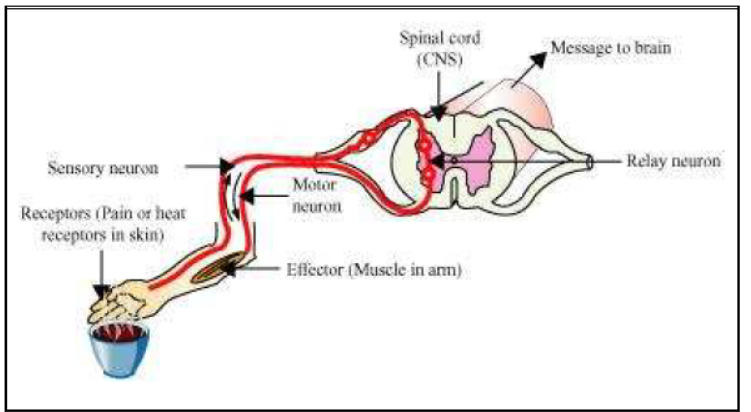
Reflex arcs are formed in the spinal cord and the information (input) reaches the brain. The brain is only aware of the signal and the response that has taken place. However, the brain has no role to play in the creation of the response.
Question : What are plant hormones?
Answer: Plant hormones or phytohormones arenaturally-occurring organic substances. These are synthesized in one part of the plant body (in minute quantities) and are translocated to other parts when required. The five major types of phytohormones are auxins, gibberellins, cytokinins, abscisic acid, and ethylene.
Question : How is the movement of leaves of the sensitive plant different from the movement of a shoot towards light?
Answer: The movement of leaves of the sensitive plant, Mimosa pudica or “touch me not”, occurs in response to touch or contact stimuli. This movement is independent of growth. The movement of shoot towards light is known as phototropism. This type of movement is directional and is growth dependent.
Question : Give an example of a plant hormone that promotes growth.
Answer: Auxin is an example of growth-promoting plant hormone.
Question : How do auxins promote the growth of a tendril around a support?
Answer: Auxin is synthesized at the shoot tip. It helps the cell grow longer. When a tendril comes in contact with a support, auxin stimulates faster growth of the cells on the opposite side, so that the tendril forms a coil around the support. This makes the tendrils appear as a watch spring.
Question : Design an experiment to demonstrate hydrotropism.
Answer: Take two small beakers and label them as A and B. Fill beaker A with water. Now make a cylindrical-shaped roll from a filter paper and keep it as a bridge between beaker A and beaker B, as shown in the figure. Attach few germinating seeds in the middle of the filter Class X Chapter 7 – Control and Coordination Science paper bridge. Now, cover the entire set-up with a transparent plastic container so that the moisture is retained.
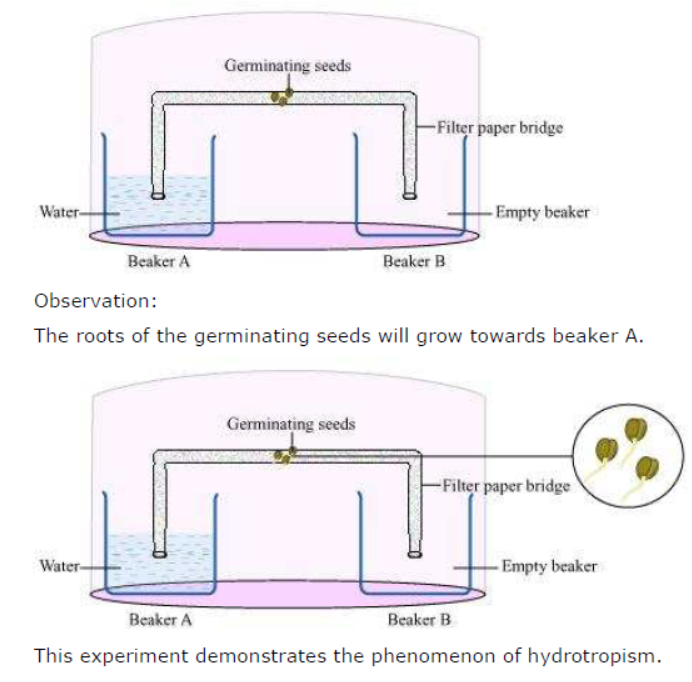
Question : How does chemical coordination take place in animals?
Answer: Chemical coordination takes place in animals with the help of hormones.Hormone is the chemical messenger that regulates the physiological processes in living organisms. It is secreted by glands. The regulation of physiological processes, and control and coordination by hormones comes under the endocrine system. The nervous system along with the endocrine system in our body controls and coordinates the physiological processes.
Question : Why is the use of iodised salt advisable?
Answer: Iodine stimulates the thyroid gland to produce thyroxin hormone. It regulates carbohydrate, fat, and protein metabolism in our body. Deficiency of this hormone results in the enlargement of the thyroid gland. This can lead to goitre, a disease characterized by swollen neck. Therefore, iodised salt is advised for normal functioning of the thyroid gland.
Question : How does our body respond when adrenaline is secreted into the blood?
Answer: Adrenalin is a hormone secreted by the adrenal glands in case of any danger or emergency or any kinds of stress. It is secreted directly into the blood and is transported to different parts of the body. When secreted in large amounts, it speeds up the heartbeat and hence supplies more oxygen to the muscles. The breathing rate also increases due to contractions of diaphragm and rib muscles. It also increases the blood pressure. All these responses enable the body to deal with any stress or emergency.
Question : Why are some patients of diabetes treated by giving injections of insulin?
Answer: Diabetes is a disease in which the level of sugar in the blood is too high. Insulin, a hormone secreted by the pancreas, helps in regulating the blood sugar levels. This is the reason why diabetic patients are treated by giving injections of insulin.
Question : Which of the following is a plant hormone?
(a) Insulin
(b) Thyroxin
(c) Oestrogen
(d) Cytokinin
Answer: (d) Cytokinin is a plant hormone.
Question : The gap between two neurons is called a
(a) dendrite.
(b) synapse.
(c) axon.
(d) impulse.
Answer: (b) The gap between two neurons is called a synapse.
Question : The brain is responsible for
(a) thinking.
(b) regulating the heart beat.
(c) balancing the body.
(d) all of the above.
Answer: (d) The brain is responsible for thinking, regulating the heart beat and balancing the body.
Question : What is the function of receptors in our body? Think of situations where receptors do not work properly. What problems are likely to arise?
Answer: Receptors are sensory structures (organs/tissues or cells) present all over the body. The receptors are either grouped in case of eye or ear, or scattered in case of skin.
Functions of receptors:
(i) They sense the external stimuli such as heat or pain.
(ii) They also trigger an impulse in the sensory neuron which sends message to the spinal cord.
When the receptors are damaged, the external stimuli transferring signals to the brain are not felt. For example, in the case of damaged receptors, if we accidentally touch any
hot object, then our hands might get burnt as damaged receptors cannot perceive the external stimuli of heat and pain.
Question : Draw the structure of a neuron and explain its function.
Answer: Neurons are the functional units of the nervous system. The three main parts of a neuron are axon, dendrite, and cell body.
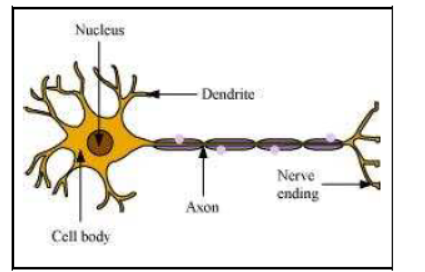
Functions of the three parts of a neuron:
Axon: It conducts messages away from the cell body.
Dendrite: It receives information from axon of another cell and conducts the messages towards the cell body.
Cell body: It contains nucleus, mitochondria, and other organelles. It is mainly
concerned with the maintenance and growth.
Question : What are the changes seen in girls at the time of puberty?
Answer: Secondary sexual characteristics in girls:
· Increase in breast size and darkening of skin of the nipples present at the tips of the breasts.
· Appearance of hair in the genital area.
· Appearance of hair in other areas of skin like underarms, face, hands, and legs.
· Increase in the size of uterus and ovary.
· Beginning of menstrual cycle.
· More secretion of oil from the skin, which results in the appearance of pimples.
Question : Which signals will get disrupted in case of a spinal cord injury?
Answer: The reflex arc connections between the input and output nerves meet in a bundle in the spinal cord. In fact, nerves from all over the body meet in a bundle in the spinal cord on their way to the brain. In case of any injury to the spinal cord, the signals coming from the nerves as well as the signals coming to the receptors will be disrupted.
Question : How does chemical coordination occur in plants?
Answer: In animals, control and coordination occur with the help of nervous system. However,plants do not have a nervous system.
Plants respond to stimuli by showing movements. The growth, development, and responses to the environment in plants is controlled and coordinated by a special class of chemical substances known as hormones. These hormones are produced in one part of the plant body and are translocated to other needy parts. For example, a hormone produced in roots is translocated to other parts when required. The five major types of phytohormone are auxins, gibberellins, cytokinins, abscisic acid, and ethylene. These phytohormones are either growth promoters (such as auxins, gibberellins, cytokinins, and ethylene) or growth inhibitors such as abscisic acid.
Question : What is the need for a system of control and coordination in an organism?
Answer: The maintenance of the body functions in response to changes in the body by working together of various integrated body systems is known as coordination. All the movements that occur in response to stimuli are carefully coordinated and controlled. In animals, the control and coordination movements are provided by nervous and muscular systems. The nervous system sends messages to and away from the brain. The spinal cord plays an important role in the relay of messages. In the absence of this system of control and coordination, our body will not be able to function properly. For example,when we accidentally touch a hot utensil, we immediately withdraw our hand. In the absence of nerve transmission, we will not withdraw our hand and may get burnt.
Question : How are involuntary actions and reflex actions different from each other?
Answer: Involuntary actions cannot be consciously controlled. For example, we cannot consciously control the movement of food in the alimentary canal. These actions are
however directly under the control of the brain. On the other hand, the reflex actions such as closing of eyes immediately when bright light is focused show sudden response and do not involve any thinking. This means that unlike involuntary actions, the reflex actions are not under the control of brain.
Question : Compare and contrast nervous and hormonal mechanisms for control and coordination in animals.
Answer: Nervous system mechanism Hormonal system mechanism
1. The information is conveyed in the form 1. The information is conveyed in the
of electric impulse. form of chemical messengers.
2. The axons and dendrites transmit the 2. The information is transmitted or
information through a coordinated effort. transported through blood.
3. The flow of information is rapid and the 3. The information travels slowly and
response is quick. the response is slow.
4. Its effects are short lived. 4. It has prolonged effects.
Question : What is the difference between the manner in which movement takes place in a sensitive plant and the movement in our legs?
Answer:
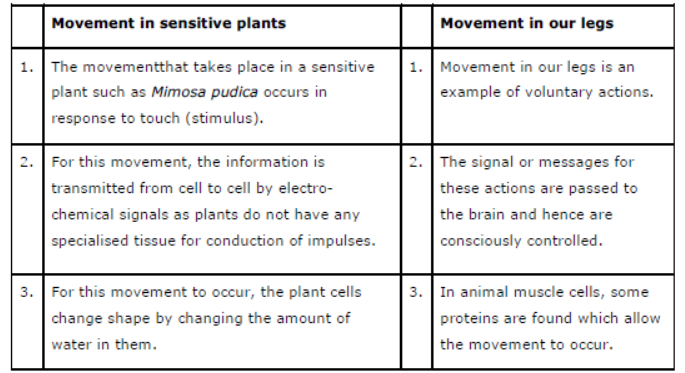
| NCERT Solutions Class 10 Science Chapter 1 Chemical Reactions and Equations |
| NCERT Solutions Class 10 Science Chapter 2 Acids Bases and Salts |
| NCERT Solutions Class 10 Science Chapter 3 Metals and Non metals |
| NCERT Solutions Class 10 Science Chapter 4 Carbon and its Compounds |
| NCERT Solutions Class 10 Science Chapter 5 Periodic Classification of Elements |
| NCERT Solutions Class 10 Science Chapter 6 Life Processes |
| NCERT Solutions Class 10 Science Chapter 7 Control and Coordination |
| NCERT Solutions Class 10 Science Chapter 8 How do Organisms Reproduce |
| NCERT Solutions Class 10 Science Chapter 9 Heredity and Evolution |
| NCERT Solutions Class 10 Science Chapter 10 Light Reflection and Refraction |
| NCERT Solutions Class 10 Science Chapter 11 Human Eye and Colourful World |
| NCERT Solutions Class 10 Science Chapter 12 Electricity |
| NCERT Solutions Class 10 Science Chapter 13 Magnetic Effects of Electric current |
| NCERT Solutions Class 10 Science Chapter 14 Sources of Energy |
| NCERT Solutions Class 10 Science Chapter 15 Our Environment |
| NCERT Solutions Class 10 Science Chapter 16 Management of Natural Resources |
NCERT Solutions Class 10 Science Chapter 7 Control and Coordination
The above provided NCERT Solutions Class 10 Science Chapter 7 Control and Coordination is available on our website for free download in Pdf. You can read the solutions to all questions given in your Class 10 Science textbook online or you can easily download them in pdf. The answers to each question in Chapter 7 Control and Coordination of Science Class 10 has been designed based on the latest syllabus released for the current year. We have also provided detailed explanations for all difficult topics in Chapter 7 Control and Coordination Class 10 chapter of Science so that it can be easier for students to understand all answers. These solutions of Chapter 7 Control and Coordination NCERT Questions given in your textbook for Class 10 Science have been designed to help students understand the difficult topics of Science in an easy manner. These will also help to build a strong foundation in the Science. There is a combination of theoretical and practical questions relating to all chapters in Science to check the overall learning of the students of Class 10.
You can download the NCERT Solutions for Class 10 Science Chapter 7 Control and Coordination for latest session from StudiesToday.com
Yes, the NCERT Solutions issued for Class 10 Science Chapter 7 Control and Coordination have been made available here for latest academic session
Regular revision of NCERT Solutions given on studiestoday for Class 10 subject Science Chapter 7 Control and Coordination can help you to score better marks in exams
Yes, studiestoday.com provides all latest NCERT Chapter 7 Control and Coordination Class 10 Science solutions based on the latest books for the current academic session
Yes, NCERT solutions for Class 10 Chapter 7 Control and Coordination Science are available in multiple languages, including English, Hindi
All questions given in the end of the chapter Chapter 7 Control and Coordination have been answered by our teachers

